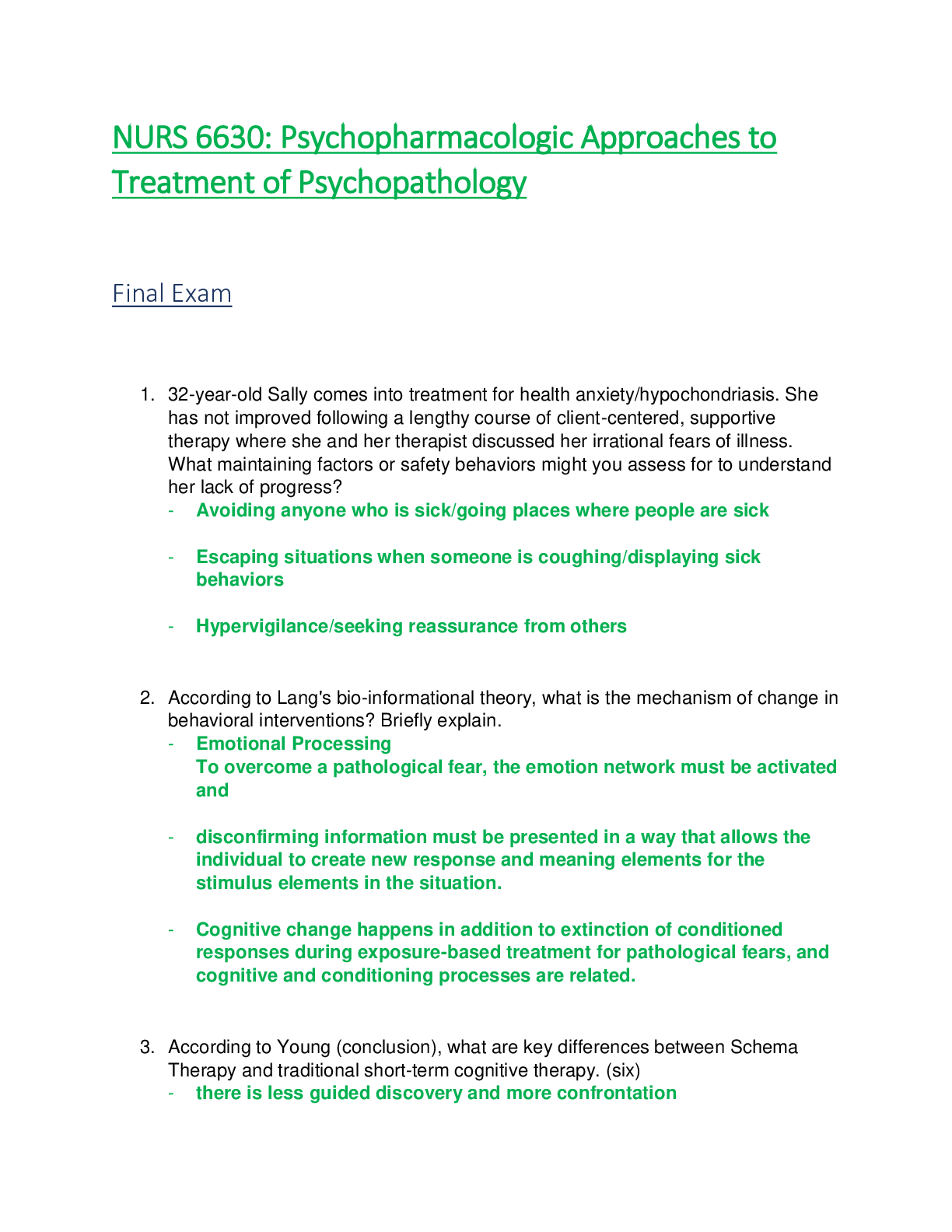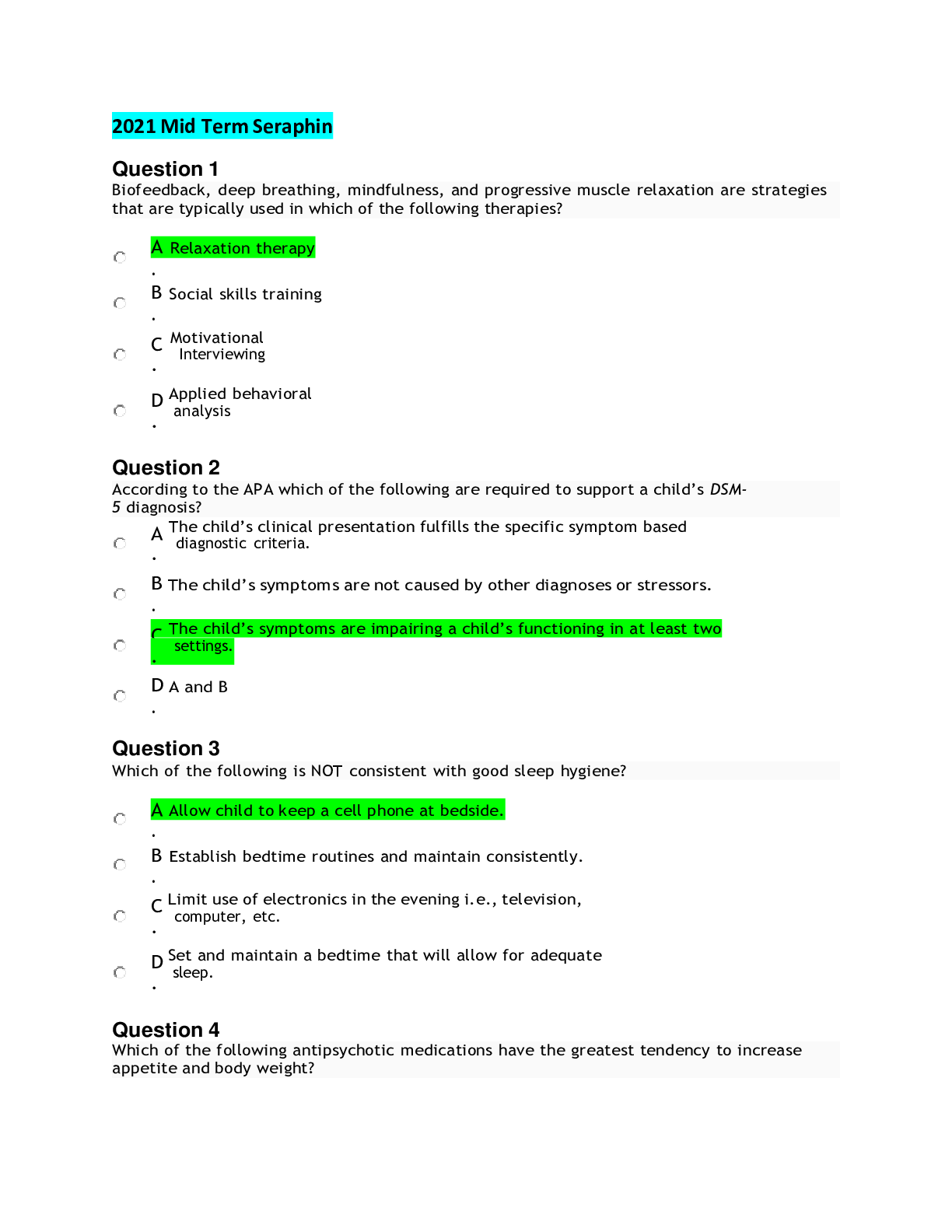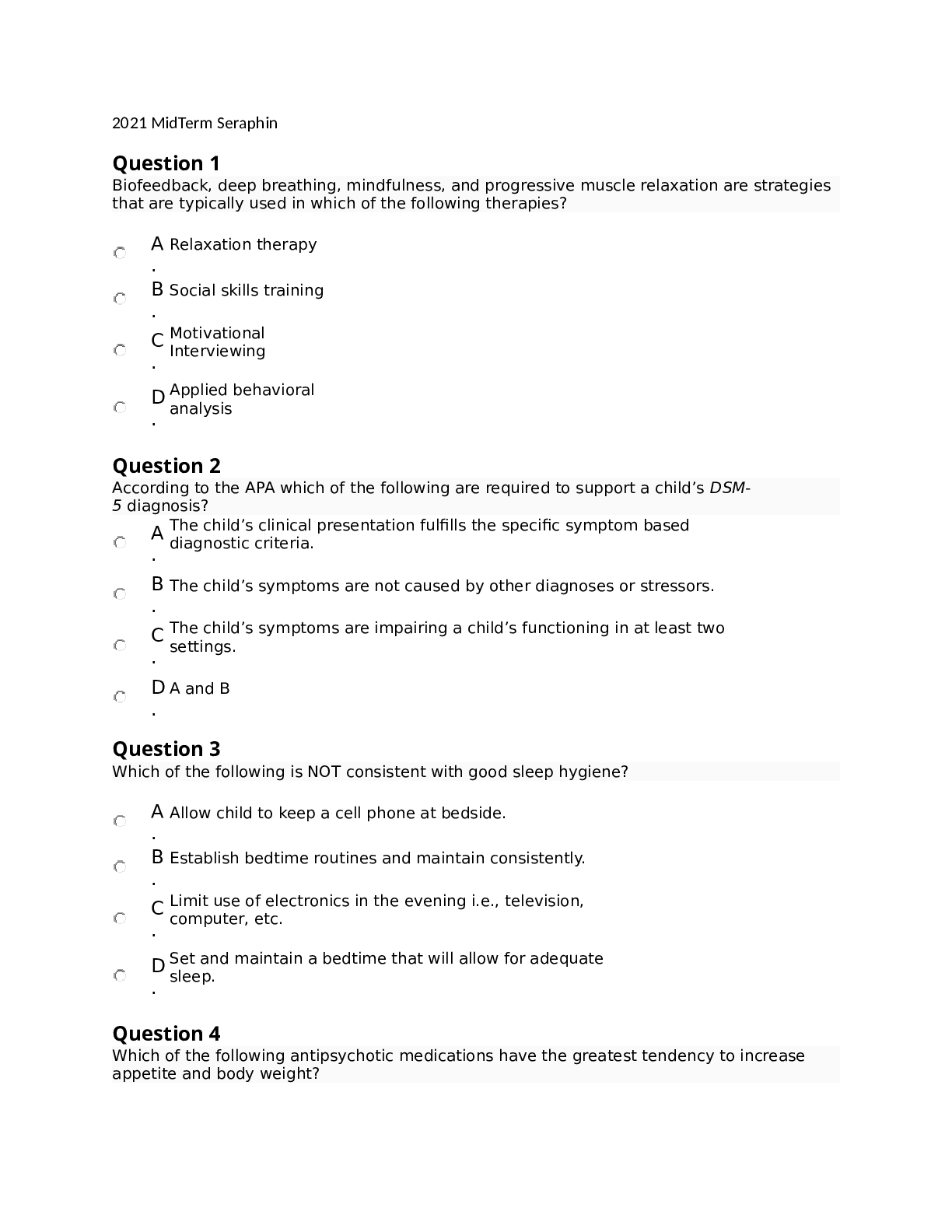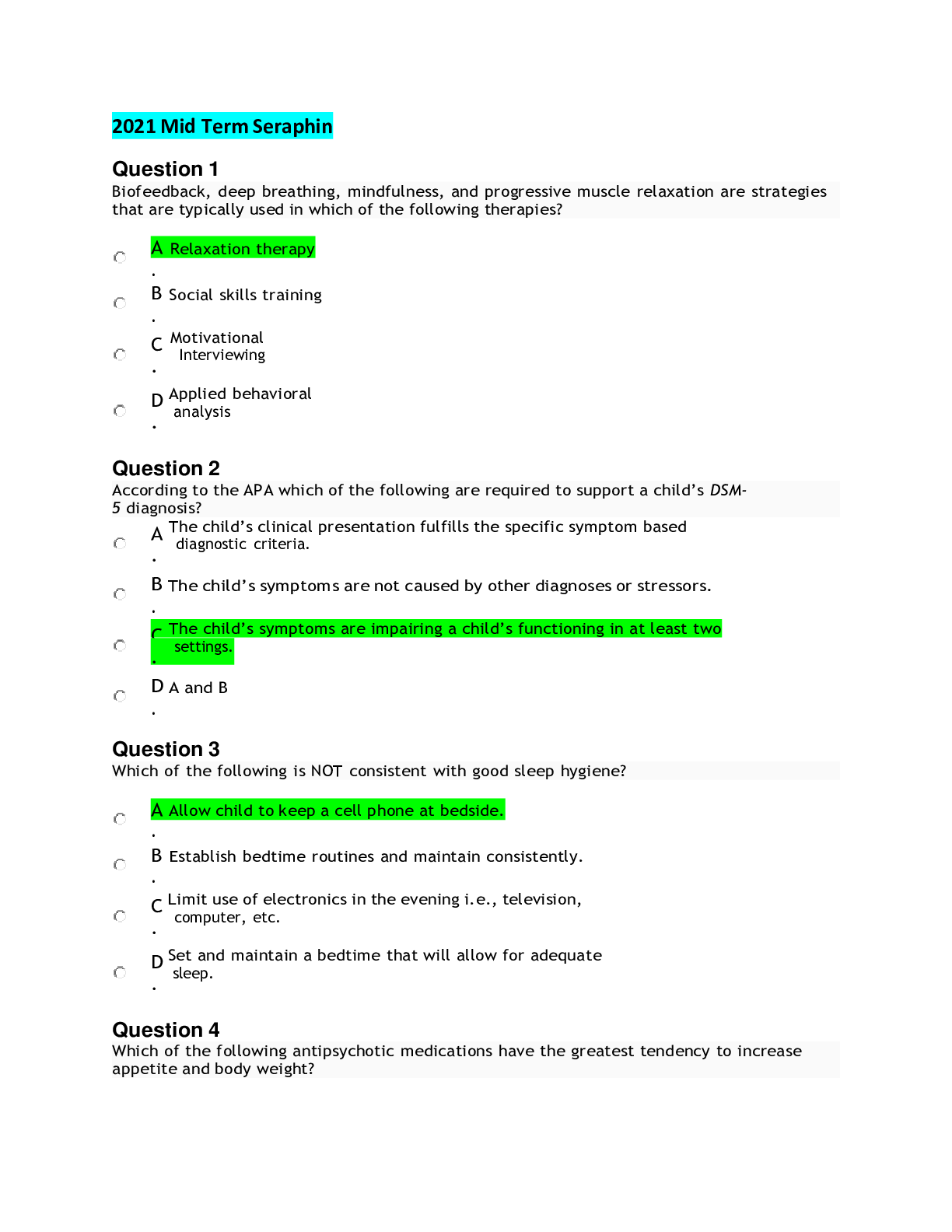Education > EXAM > Emergency Department Final Exam » Scribe Training/ Emergency Department Final Exam. Results 84 of 1 (All)
Emergency Department Final Exam » Scribe Training/ Emergency Department Final Exam. Results 84 of 100 questions answered correctly/ (123 of 140 point(s), (87.86%).
Document Content and Description Below
Emergency Department Final Exam » Scribe Training Answered Review Emergency Department Final Exam Time has elapsed You have reached 123 of 140 point(s), (87.86%) Categories 1. Questi... on A patient is seen in the emergency department complaining of dysuria and tells you that she is 23 weeks pregnant. Â Your doctor diagnoses her with a UTI. Â Which of the following would be the best diagnosis? Acute urinary tract infection Acute urinary tract infection in pregnancy, 1st trimester Acute urinary tract infection in pregnancy, 2nd trimester Acute urinary tract infection in pregnancy, 3rd trimester 4/22/2019 Emergency Department Final Exam » Scribe Training / 2/22 2. Question Expand the following medical abbreviation. Remember, do not include any spaces before or after the term/phrase. e.g. Correct way “Good luck” vs incorrect ” good luck “. What does “CBC” stand for? Complete blood count 3. Question Medical Terminology: Expand the following medical abbreviation into the full medical term. Remember, do not include any spaces before or after the term/phrase. e.g. Correct way “Good luck” vs incorrect ” good luck “. What does the DP stand for in “DP pulse”? Dorsalis pedis 4. Question Expand the following medical abbreviation. Remember, do not include any spaces before or after the term/phrase. e.g. Correct way “Good luck” vs incorrect ” good luck “. What does “s/p” stand for? status post 5. Question Expand the following medical abbreviation. Remember, do not include any spaces before or after the term/phrase. e.g. Correct way “Good luck” vs incorrect ” good luck “. What does “AAA” stand for? abdominal aortic aneurysm 6. Question Medical Terminology: Expand the following medical abbreviation into the full medical term. Remember, do not include any spaces before or after the term/phrase. e.g. Correct way “Good luck” vs incorrect ” good luck “. What does “DOE” stand for? dyspnea on exertion 7. Question Expand the following medical abbreviation. Remember, do not include any spaces before or after the term/phrase. e.g. Correct way “Good luck” vs incorrect ” good luck “. What does “PNA” stand for? pneumonia 8. Question Expand the following medical abbreviation. Remember, do not include any spaces before or after the term/phrase. e.g. Correct way “Good luck” vs incorrect ” good luck “. What does “IDDM” stand for? Do not include any hyphenations for your answer. insulin dependent diabetes mellitus 4/22/2019 Emergency Department Final Exam » Scribe Training / 3/22 9. Question Expand the following medical abbreviation. Remember, do not include any spaces before or after the term/phrase. e.g. Correct way “Good luck” vs incorrect ” good luck “. What does “TIA” stand for? transient ischemic attack 10. Question Expand the following medical abbreviation. Remember, do not include any spaces before or after the term/phrase. e.g. Correct way “Good luck” vs incorrect ” good luck “. What does “COPD” stand for? chronic obstructive pulmonary disease 11. Question Expand the following medical abbreviation. Remember, do not include any spaces before or after the term/phrase. e.g. Correct way “Good luck” vs incorrect ” good luck “. What does “NTG” stand for? nitroglycerin 12. Question Expand the following medical abbreviation. Remember, do not include any spaces before or after the term/phrase. e.g. Correct way “Good luck” vs incorrect ” good luck “. What does “CHF” stand for? congestive heart failure 13. Question Diagnosis: Expand the following medical abbreviation into the full medical term. Remember, do not include any spaces before or after the term/phrase. e.g. Correct way “Good luck” vs incorrect ” good luck “. What does “PE” stand for in the Diagnosis section of the chart? pulmonary embolism 14. Question Expand the following medical abbreviation. Remember, do not include any spaces before or after the term/phrase. e.g. Correct way “Good luck” vs incorrect ” good luck “. What does “AMS” stand for? altered mental status 15. Question Medical Terminology: Expand the following medical abbreviation into the full medical term. Remember, do not include any spaces before or after the term/phrase. e.g. Correct way “Good luck” vs incorrect ” good luck “. What does “CVA” stand for in the PE section? costovertebral angle 16. Question 4/22/2019 Emergency Department Final Exam » Scribe Training / 4/22 Expand the following medical abbreviation. Remember, do not include any spaces before or after the term/phrase. e.g. Correct way “Good luck” vs incorrect ” good luck “. What does “URI” stand for? upper respiratory infection 17. Question Expand the following medical abbreviation. Remember, do not include any spaces before or after the term/phrase. e.g. Correct way “Good luck” vs incorrect ” good luck “. What does “LBBB” stand for? left bundle branch block 18. Question Medical Terminology: Expand the following medical abbreviation into the full medical term. Remember, do not include any spaces before or after the term/phrase. e.g. Correct way “Good luck” vs incorrect ” good luck “. What does “DVT” stand for? deep vein thrombosis 19. Question Expand the following medical abbreviation. Remember, do not include any spaces before or after the term/phrase. e.g. Correct way “Good luck” vs incorrect ” good luck “. What does “EOMI” stand for? (Hint: 3 words.) Do not include hyphens (-) when typing in your answer. extraocular movements intact 20. Question Expand the following medical abbreviation. Remember, do not include any spaces before or after the term/phrase. e.g. Correct way “Good luck” vs incorrect ” good luck “. What does “GERD” stand for? (Hint: three words.) gastroesophageal reÞux disease 21. Question Medical Terminology: Expand the following medical abbreviation into the full medical term. Remember, do not include any spaces before or after the term/phrase. e.g. Correct way “Good luck” vs incorrect ” good luck “. What does “CSF” stand for? cerebrospinal Þuid 22. Question Expand the following medical abbreviation. Remember, do not include any spaces before or after the term/phrase. e.g. Correct way “Good luck” vs incorrect ” good luck “. What does “DNR” stand for? do not resuscitate 23. Question 4/22/2019 Emergency Department Final Exam » Scribe Training / 5/22 Medical Terminology: Expand the following medical abbreviation into the full medical term. Remember, do not include any spaces before or after the term/phrase. e.g. Correct way “Good luck” vs incorrect ” good luck “. What does “PTX” stand for? pneumothorax 24. Question Expand the following medical abbreviation. Remember, do not include any spaces before or after the term/phrase. e.g. Correct way “Good luck” vs incorrect ” good luck “. What does “GCS” stand for? glasgow coma scale 25. Question A 43-year-old male presents to the ED with vomiting that began 5 hours ago. He has a history of Type II DM and is s/p right BKA. On objective evaluation it is found that he is hyperglycemic and has elevated ketones and so he will be admitted for DKA. Match the details to the correct section of the chart. Do not change the positioning of an answer after it is placed. Sort elements Onset 5 hours ago PMHx Type II DM Diagnosis DKA CC vomiting ED Course hyperglycemia and elevated ketones Disposition admit PSHx right BKA 26. Question Which section of the chart would you znd AKA? (Select all that apply.) PSHx FHx SHx PMHx Disposition PE 27. Question 4/22/2019 Emergency Department Final Exam » Scribe Training / 6/22 T/F. It’s the middle of the day. Your provider is busy dealing with a crtically ill patient and during this time the ED starts to pick up pace as more patients arrive. While your provider is prepping the critical patient for a procedure, she asks you to look up the CBC result on another patient. You quickly look up the information on your laptop and tell the physician that the labs came back normal except for a blood glucose level of 356, so your provider subsequently asks you to tell the nurse to start that patient on an insulin drip. You locate the nurse and relay the message. This scenario is acceptable and within the bounds of your scribe scope. False True 28. Question Which of the following would be documented in ED Course? (select all that apply.) Physical exam Treatments Re-evals Family history Orders History of present illness Interpretations Review of systems Disposition note 29. Question Match the following description to the appropriate team member. Do not change the positioning of an answer after it is placed. Sort elements Scribe Documents the patient’s visit on behalf of the physician Unit Secretary Answers phone calls, pages other specialists/doctors, and organizes the patient’s paperwork. RT Administers “breathing treatments” and assists with managing a patient’s airway. ED Tech Helps the nurse and assists with procedures. Charge Nurse Manages the ED patient {ow. Mid-Level Provider NP or PA that works under the supervision of a physician to diagnose and treat patients. ED Nurse Records medical histories, symptoms, monitors the patient, starts IVs, administers medications, and assists with procedures. 30. Question Match the following Dx with it’s patient presentation. Sort elements 4/22/2019 Emergency Department Final Exam » Scribe Training / 7/22 PE SOB + unilateral pedal edema + pleuritic CP CHF SOB + bilateral pedal edema + CP asthma SOB + wheezing on exam COPD SOB + wheezing on exam + Shx of 3 ppd 31. Question Diagnosis: What condition correctly describes “An immune response that leads to rash, itching, swelling, or dixculty breathing”? Hint: 2 words. allergic reaction 32. Question Certain words or phrases act as “red {ags” to grab your provider’s attention to let let them know that a patient may require timely and comprehensive medical action. Which of the following words or phrases are NOT considered a “red {ag?” "tearing pain in the central chest going straight through to the back" in a 40 y/o female "neonatal fever" "thunderclap headache" from a 56 y/o female "nocturia" in a 65 y/o male "chest pain" in a 45 y/o female "lethargy" in a 3 year old boy "worst headache of my life" from a 32 y/o male 33. Question Diagnosis: What condition correctly describes “Fertilized egg develops outside the uterus”? ectopic pregnancy 34. Question Which of the following are not valid DDx for a patient with CC of HA? hypertensive HA Bell's Palsy migraine Vertigo hemorrhagic CVA Syncope 35. Question What condition correctly describes “translocation of a thrombus leading to dyspnea and hypoxia”? Use the abbreviation form of the condition. (Remember, do not include any spaces before or after the term/phrase.) 4/22/2019 Emergency Department Final Exam » Scribe Training / 8/22 PE 36. Question A patient recently went on a boat trip 2 days ago and developed dizziness which has continued to persist since onset. She describes her dizziness as a room spinning and reports that it is accompanied by tinnitus, nausea, and vomiting. Physical exam is positive for Romberg’s and Head CT is negative. Based on this information which is the most likely znal diagnosis for the patient? CVA Bell's palsy BPV Syncope 37. Question An ROS has marked positive for head trauma with accompanying LOC. What DDx would your provider be concerned about? Hemorrhagic CVA meningitis Ischemic CVA TIA 38. Question What condition correctly describes “A vascular change that temporarily deprives a part of the brain of oxygen but does not result in any long lasting dezcits”? Use the abbreviation form of the condition. (Remember, do not include any spaces before or after the term/phrase.) TIA 39. Question A patient states she has had a productive cough for 4 days, and yesterday she developed a fever. Would her fever be considered an associated symptom for her productive cough? Why or why not? No, because the fever started later and not on the same day as the cough Yes, because the fever started soon after the cough Yes, because fever causes sputum production 40. Question T/F. All symptoms documented in the HPI are also documented in the ROS. False True 41. Question Which of the following are considered to be cardiac risk factors for CP patients? (select all that apply.) Family hx of CAD <55 y/o none of the above tobacco use HLD PSHx of CABG, angioplasty, and stent 4/22/2019 Emergency Department Final Exam » Scribe Training / 9/22 HTN DM CAD 42. Question You are writing an HPI for a very complex patient who has had multiple recent hospital admissions and several signizcant complaints; what is the best way to organize the information in your HPI? Descending order by relevant organ system Ascending order by relevant organ system Alphabetical order by element Chronological order Rank by importance of element 43. Question Location is an important element that can paint a picture for concerning DDx. Match location with the corresponding DDx. Sort elements RLQ appendicitis LUQ pancreatic disease RUQ gall bladder disease LLQ diverticulitis 44. Question How would you document GPA for a patient who has previously been pregnant four times in the past, has three children at home, and is NOT currently pregnant? (Type your answer using the following format: “G,P,A” “#,#,#”; so for example you woud type 0,0,0 with no spaces before or after the answer) 4,3,1 45. Question A 45 year old male presents to the ED with a ripping, tearing pain to his central chest radiating straight to his back with associated nausea that began 1 hour ago. What emergency conditions (ideally from what you have learned in CRT) from the following list may explain the patient’s symptoms? AAA and Aortic Dissection MI and Aortic Dissection MI and AAA AAA, Aortic Dissection, and MI 46. Question T/F. All symptoms documented in the ROS are also documented in the HPI. True 4/22/2019 Emergency Department Final Exam » Scribe Training / 10/22 False 47. Question For chest pain patients, administering this medication can prevent onset of MI by thinning out the blood and improving blood {ow to the heart. Because of this, it is important to document in the HPI if the patient received this medication, and if so who gave the medication and what was the dosage of the medication. What medication is important for meeting this core measure? Coumadin NSAIDS Epi pen Insulin ASA Acetaminophen 48. Question A female patient has been pregnant four times in the past, is currently pregnant, and has two children at home. Calculate the G, P and A, respectively. (Type your answer using the following format: “G,P,A” “#,#,#”; so for example you woud type 0,0,0 with no spaces before or after the answer) 5,2,2 49. Question Quality is an important descriptor that can paint a picture for concerning DDx. Match the following HPI detail with the corresponding DDx. Sort elements chest pains when taking in a deep breath PTX sharp, stabbing pains that alternatly becomes a dull heavy pressure like an elephant sitting on the chest, but regardless of quality, pain is always brought on by exertion CAD/MI burning chest pain GERD 50. Question What FHx/SHx information is usually asked for pediatric patients? (Select all that apply.) History of cardiac disease Second hand smoke exposure Smoking history Immunization status Current occupation 4/22/2019 Emergency Department Final Exam » Scribe Training / 11/22 51. Question Medical terminology. What is the medical term for stones in the gallbladder? (Remember, when typing your answer, do not include any spaces before or after the term/phrase. e.g. Correct way “Good luck” vs incorrect ” good luck “.) cholelithiasis 52. Question Medical Terminology: What is the medical term for “carotid artery cleaning”? (Remember, when typing your answer, do not include any spaces before or after the term/phrase. e.g. Correct way “Good luck” vs incorrect ” good luck “.) carotid endarterectomy 53. Question Medical terminology. What is the medical term for infection of the gall bladder? (Remember, when typing your answer, do not include any spaces before or after the term/phrase. e.g. Correct way “Good luck” vs incorrect ” good luck “.) cholecystitis 54. Question What is the medical term for painful urination? (Remember, when typing your answer, do not include any spaces before or after the term/phrase. e.g. Correct way “Good luck” vs incorrect ” good luck “.) dysuria 55. Question What medical term describes “noticeable blood in the urine”? (Remember, when typing your answer, do not include any spaces before or after the term/phrase. e.g. Correct way “Good luck” vs incorrect ” good luck “.) hematuria 56. Question What ROS system would include Dyspepsia, the medical term for indigestion? Psychiatric Eyes ENT Genitourinary Gastrointestinal Musculoskeletal General/constitutional Neurological Cardiac Respiratory 57. Question What is the medical term for “bright red blood in stools”? (Remember, when typing your answer, do not include any spaces before or after the term/phrase. e.g. Correct way “Good luck” vs incorrect ” good luck “.) 4/22/2019 Emergency Department Final Exam » Scribe Training / 12/22 hematochezia 58. Question What medical term describes “blood present in vomit”? (Remember, when typing your answer, do not include any spaces before or after the term/phrase. e.g. Correct way “Good luck” vs incorrect ” good luck “.) hematemesis 59. Question What is the medical term for “coughing up blood”? (Remember, when typing your answer, do not include any spaces before or after the term/phrase. e.g. Correct way “Good luck” vs incorrect ” good luck “.) hemoptysis 60. Question Which of the following would NOT be considered an example of PHI? (select all that apply.) Photos of an injury MRN Diagnosis Fax number Email address The name of the medical clinic that a patient receives care at Results of pending studies Social security number Home address Headshot Driver's license number Home phone number None of the above Cell phone number Type of insurance DOB 61. Question George is employed with SA as a scribe. He was ow today and accidentally cut his cheek while practicing his sword swallowing skills. He goes to the Emergency Department and is seen by a doctor and another scribe. The Emergency Department is extremely busy, and so George decides to help out the doctor by scribing his own note using the computer in the room. Has George taken the appropriate steps in this situation? No, this is a HIPAA violation because George is sharing Protected Health Information. Yes, this is acceptable because George is cleared to work at the hospital and has worked many times with the physician. No, because George accessed his own medical record using his EMR login. Yes, this is acceptable because George was directly involved with his own care. 62. Question 4/22/2019 Emergency Department Final Exam » Scribe Training / 13/22 If a patient signs a waiver giving you permission to capture photo of their unique rash, would you be committing a HIPAA violation by using your cellphone to capture the photo? (Select the best option.) No because the phone is not an approved hospital device. Yes because the phone is not an approved hospital device. No because the phone is not an approved hospital device and it is not encrypted. Yes because the phone is not an approved hospital device and it is not encrypted. Yes because the phone is not encrypted. No because the phone is not encrypted. 63. Question What are the possible consequences of a HIPAA violation? (select all that apply) Violator is blacklisted from medical programs like Medical, PA, or NP school Termination Scribe program cancellation Monetary Ýnes to you and the hospital Lawsuit against you and the hospital Prison time 64. Question A 45 year old male presents to the ED with a constant, ripping, tearing pain to his central chest radiating straight to his back with associated nausea that began 1 hour ago. What element is constant? modifying factor location relevant context timing onset quality CC pertinent positive/pertinent negative severity 65. Question Read through the PE and decide if this meets Level 5 billing criteria. Genera/Constitutional: NC, AT Eyes: PERRL, EOMI ENT: moist oral mucosa Cardiac: irregularly irregular rhythm, tachycardic, no murmurs, no rubs, no gallops Respiratory: Lungs clear, no respiratory distress, no wheezing, no rales, no rhonchi Neurological: A&O x 4 Psychiatric: normal awect No, the PE does not meet Level 5 billing criteria. Yes, the PE meets Level 5 billing criteria. 4/22/2019 Emergency Department Final Exam » Scribe Training / 14/22 66. Question A patient has the following history: breast CA s/p chemoradiation therapy and mastectomy. Based on this, does the patient meet Level 5 billing criteria for this section of the chart? Yes, the PHx meets Level 5 billing criteria. No, the PHx does not meet Level 5 billing criteria. 67. Question Which of these procedures qualify as critical care procedures and would indicate that critical care time must be documented on a patient? (select all that apply) CPAP/BiPAP Arthrocentesis Intubation Sedation LP Chest tube Cardioversion Central line placement CPR 68. Question Fill in the blank: Critical care must be at least a minimum of __________. 60 minutes 25 minutes 30 minutes 35 minutes 69. Question Among the following diseases listed, select the ones that qualify for CCT. ACS Acute MI Stable angina PTX PE Sepsis DKA Pleuritis CVA A-Ýb with RVR Costochondritis 70. Question Match each critical care dx with it’s associated procedur©e. 2019 ScribeAmerica. All rights reserved. 4/22/2019 Emergency Department Final Exam » Scribe Training / 15/22 Sort elements Respiratory failure Intubation Abnormal heart rhythm Cardioversion PTX Chest tube Cardiac arrest CPR Acute exacerbation CHF/COPD (Severe) CPAP/BiPAP Sepsis Central line placement 71. Question What do you need to make sure to document for every admitted patient? (select the best option.) A consultation note indicating the admitting physician A work excuse Prescriptions Discharge paperwork 72. Question A patient cut his left foot on a piece of glass two hours ago and is seen in the emergency department to have sutures placed. The doctor tells you there is no tendon injury and circulatory, sensory and motor is intact. What is the best diagnosis for his complaint? Uncomplicated laceration of the foot – initial encounter Laceration of the foot Laceration of the left foot Uncomplicated laceration of the left foot – initial encounter 73. Question What abbreviation describes the scenario in which a patient declines a hospital stay and decides to go home instead? (Remember, do not include any spaces before or after the term/phrase. e.g. Correct way “Good luck” vs incorrect ” good luck “.) AMA 74. Question Which of the following would need to go into a consult note for a patient that will be admitted to the hospital for treatment of bacterial meningitis? Reason for refusal of tx Discussion of R/B/A and consequences of refusing tx F/u with specialist or PCP Mode of transportation 4/22/2019 Emergency Department Final Exam » Scribe Training / 16/22 Consultation note with accepting physician Patient mental capacity Condition at time of admission Location in the hospital Name of the accepting facility SpeciÝc conditions for return to the ED Timing of admission Name of the accepting physician Time period for f/u 75. Question A 13 y/o male patient was riding his bike earlier today and accidentally fell ow after traveling on an uneven patch of sidewalk. He landed onto his outstretched right hand and subsequently experienced localized pain and swelling to the his right wrist. An x-ray of the right wrist shows a distal radial fracture. Now that the results are back, the physician will be ready to discharge the patient home. Which of the following would need to go into this patient’s disposition note? (Select all that apply.) SpeciÝc conditions for return to the ED Condition at time of disposition Consultation note with accepting physician Name of the accepting physician Mode of transportation Reason for refusal of tx Timing of disposition Location in the hospital F/u with specialist or PCP Discussion of R/B/A and consequences of refusing tx Name of the accepting facility Time period for f/u Patient mental capacity 76. Question What term describes “the patient destination is home”? (Remember, do not include any spaces before or after the term/phrase. e.g. Correct way “Good luck” vs incorrect ” good luck “.) discharged 77. Question What is a “GI cocktail”? Medication to control blood sugar An alcoholic beverage Liquid consumed by mouth to treat an upset stomach An antihistamine 78. Question 4/22/2019 Emergency Department Final Exam » Scribe Training / 17/22 Select the EKG interpretation documentation guidelines. (select all that apply.) 2 positive or negative Ýndings Number of views Type Rate and rhythm 3 positive or negative Ýndings 79. Question You are starting your shift and your physician immediately picks up 3 patients. The zrst patient is presenting with a productive cough steadily worsening since onset 4 weeks ago. The second patient has had abdominal discomfort slowly localizing into the right lower abdomen with accompanying fever over the last 6 hours and on PE, the patient has RLQ tenderness on palpation. The third patient has urinary sx and urinedip has already resulted and is positive for leukocytes and bacteria. Given the information, what might the most likely diagnoses’ end up being for these patients? PNA, Pancreatitis, UTI URI, Cholecystitis, UTI PNA, Appendicitis, negative for UTI PNA, Appendicitis, UTI TB, Diverticulitis, Urosepsis 80. Question Consent should be documented any time a procedure is performed, but there maybe certain situations in which consent is unobtainable. In that case, consent is precluded by clinical urgency. During which of the following procedures would consent usually be unobtainable? (Select the best response.) Arthrocentesis Nail trephination CPR Disimpaction 81. Question Match the oxygen administration route to the corresponding deznition. Sort elements FM A plastic mask zt over the nose and mouth. NC A plastic tube placed into the patient’s nostrils. RA This means the patient is not on oxygen. Intubation An ETT goes through the patient’s mouth and down the trachea. BVM A large facial mask held in place by hand and attached to an Ambu-bag used to manually in{ate the patient’s lungs 4/22/2019 Emergency Department Final Exam » Scribe Training / 18/22 non-rebreather mask A facial mask with a reservoir bag attached. 82. Question An ED technician informs the provider that they have just znished applying a splint and sling for the patient with the wrist fracture. What PE znding is important for your provider to assess and include in the procedure note before the patient can be discharged home? HINT: it’s an abbreviation. (Remember, do not include any spaces before or after the term/phrase. e.g. Correct way “Good luck” vs incorrect ” good luck “.) CSMT 83. Question Select terms you might znd on an x-ray interpretation. (select all that apply.) Normal QRS Pneumothorax InÝltrate No ST changes 84. Question You’ve just caught up on all of your charting. What are some things you can do to increase your providers exciency? (Select all that apply.) Start interviewing upcoming patients on their CC and PHx Accompanying your provider on reevals Preparing charts for patients that are assigned to your provider Taking blood samples to the lab Preparing for dispositions Tracking results 85. Question What does ETT stand for? Fully expand the abbreviation. (Remember, do not include any spaces before or after the term/phrase. e.g. Correct way “Good luck” vs incorrect ” good luck “.) endotracheal tube 86. Question Which of the following would be ordered to investigate thyroid disease? Troponin T-cell count TSH T3 T4 87. Question What procedure would be used to diagnose Meningitis? Expand the medical abbreviation into the full medical term. (Remember, do not include any spaces before or after the term/phrase. e.g. Correct way “Good luck” vs incorrect ” good luck “.) lumbar puncture 4/22/2019 Emergency Department Final Exam » Scribe Training / 19/22 88. Question Which of the following tests would likely be immediately ordered for a Cardiac Workup in the ED? (Select all that apply.) Cardiac Stent CBC and BMP Aspirin EKG Troponin CXR 89. Question How would you diagnose Hemorrhagic CVA? (select all that apply.) CMP CBC X-ray LP US Head CT 90. Question Which of the following diseases may be diagnosed using a CXR? (select all that apply.) PNA CHF Rib fracture PTX PE Heart function Asthma 91. Question Which of the following lab results need to be monitored closely for exciency? Creatine Lipase Troponin INR Creatinine D-dimer 92. Question How would you diagnose AFIB? Use the abbreviation to answer the question. (Remember, do not include any spaces before or after the term/phrase. e.g. Correct way “Good luck” vs incorrect ” good luck “.) EKG 4/22/2019 Emergency Department Final Exam » Scribe Training / 20/22 93. Question How would you diagnose an AAA? CT chest dry CT chest with PO contrast CT chest with IV contrast CT A/P dry CT A/P with PO contrast CT A/P with IV contrast 94. Question Match the following results with the corresponding diagnosis. Sort elements combination of (-) EKG and (+) blood work NSTEMI combination of (-) EKG and (-) blood work no MI combination of (+) EKG and (+) blood work STEMI 95. Question How would you diagnose a pneumothorax? Hint: use abbreviation. (Remember, do not include any spaces before or after the term/phrase. e.g. Correct way “Good luck” vs incorrect ” good luck “.) CXR 96. Question Which of the following would belong in a psychiatric exam? (Select all that apply.) Cranial nerve exam ReÞexes Glasgow Coma Scale Cerebellar exam Sensory exam AÜect 97. Question Your physician tells you the patient had a wood’s lamp exam to look for {uorescein uptake. In which organ system would you document this physical exam znding? Respiratory Eyes Integumentary Cardiac 4/22/2019 Emergency Department Final Exam » Scribe Training / 21/22 General/Constitutional Psychiatric ENT Gastrointestinal Genitourinary Neurological Musculoskeletal 98. Question An 23-year-old female is brought in by EMS for a motor vehicle crash. Your physician verbalizes outloud that the patient appears to be on a backboard and her cervical spine is stabilized with a hard collar. The patient also appears to be lethargic with obvious lacerations above her right eyebrow, left hand, and left thigh. Match the following exam zndings with the appropriate organ system. Sort elements patient lethargic neurological patient with a c-collar neck lacerations to the right eyebrow, left hand, and left thigh integumentary patient back-boarded back 99. Question You see the physician check the patient’s pulses in four places; the right wrist, the top of the right foot, the back of the right foot and the left neck. The doctor states “The pulses are zne”. Match the location with the appropriate pulse that you would document in the physical exam? Sort elements back of foot 2+ DPP wrist 2+ radial pulse top of foot 2+ PTP neck 2+ carotid 100. Question Match the normal grading scale with the corresponding PE znding. Sort elements GCS © 2019 ScribeAmeric 15 a. All rights reserved. 4/22/2019 Emergency Department Final Exam » Scribe Training / 22/22 Re{exes 2+ Strength 5/5 [Show More]
Last updated: 1 year ago
Preview 1 out of 22 pages

Reviews( 0 )
Document information
Connected school, study & course
About the document
Uploaded On
Dec 15, 2021
Number of pages
22
Written in
Additional information
This document has been written for:
Uploaded
Dec 15, 2021
Downloads
1
Views
108



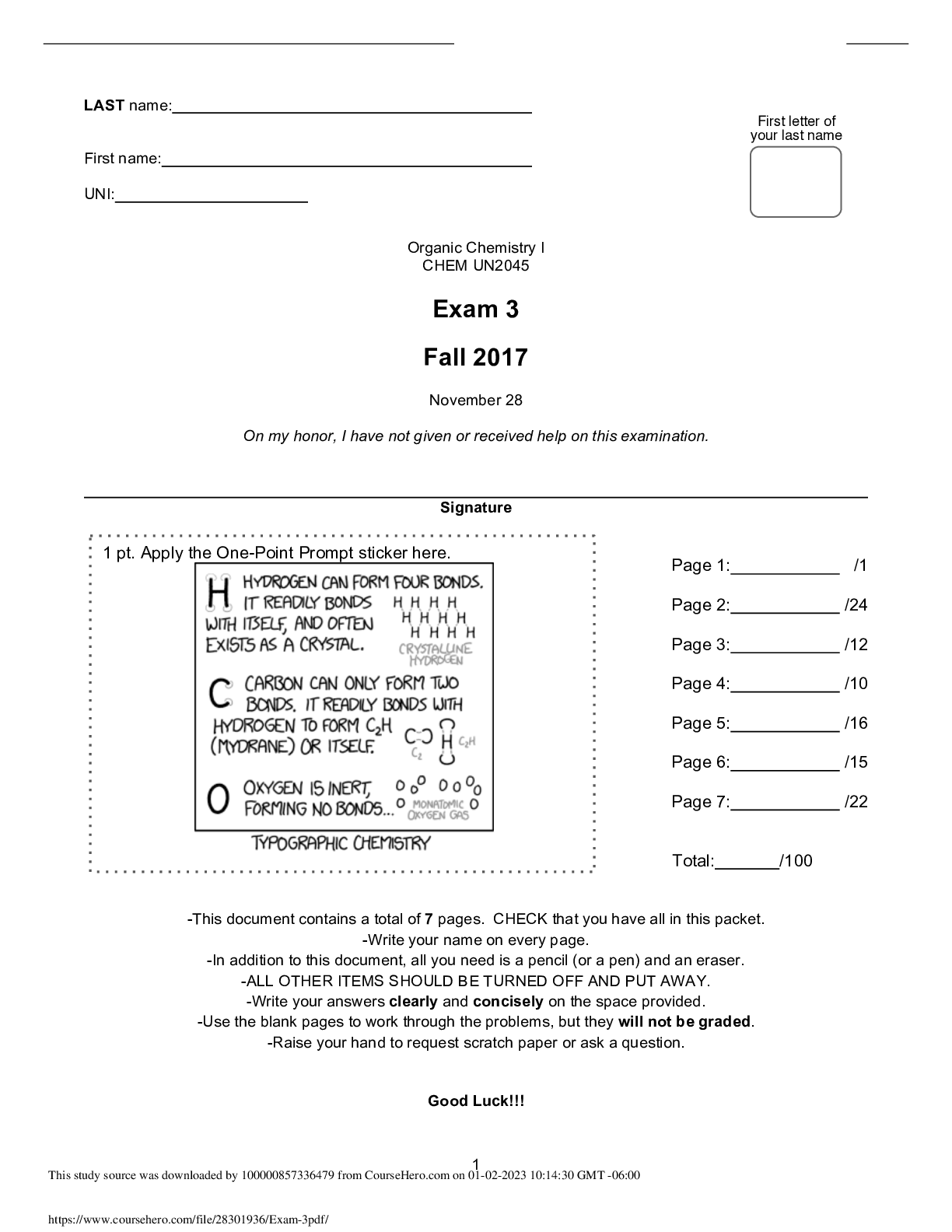

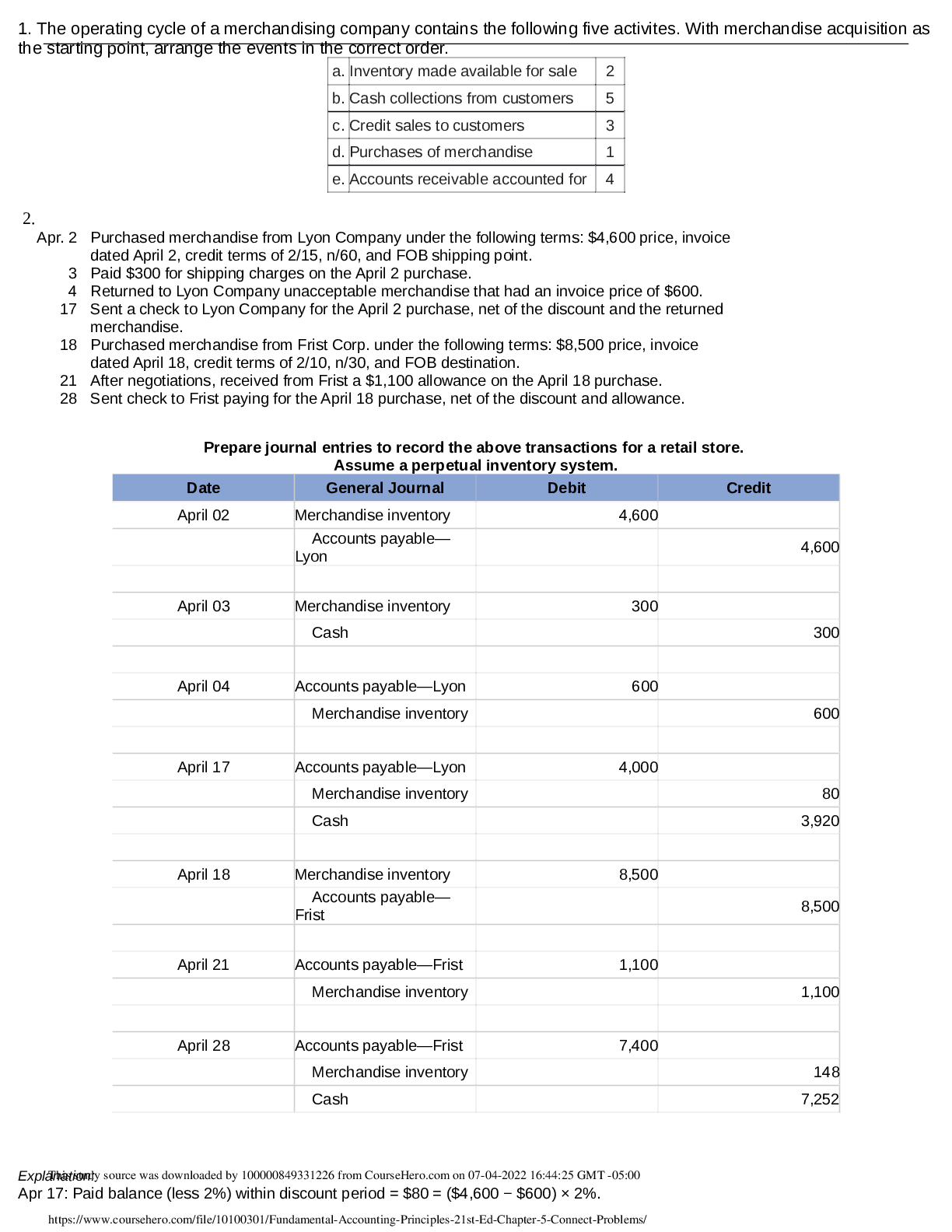
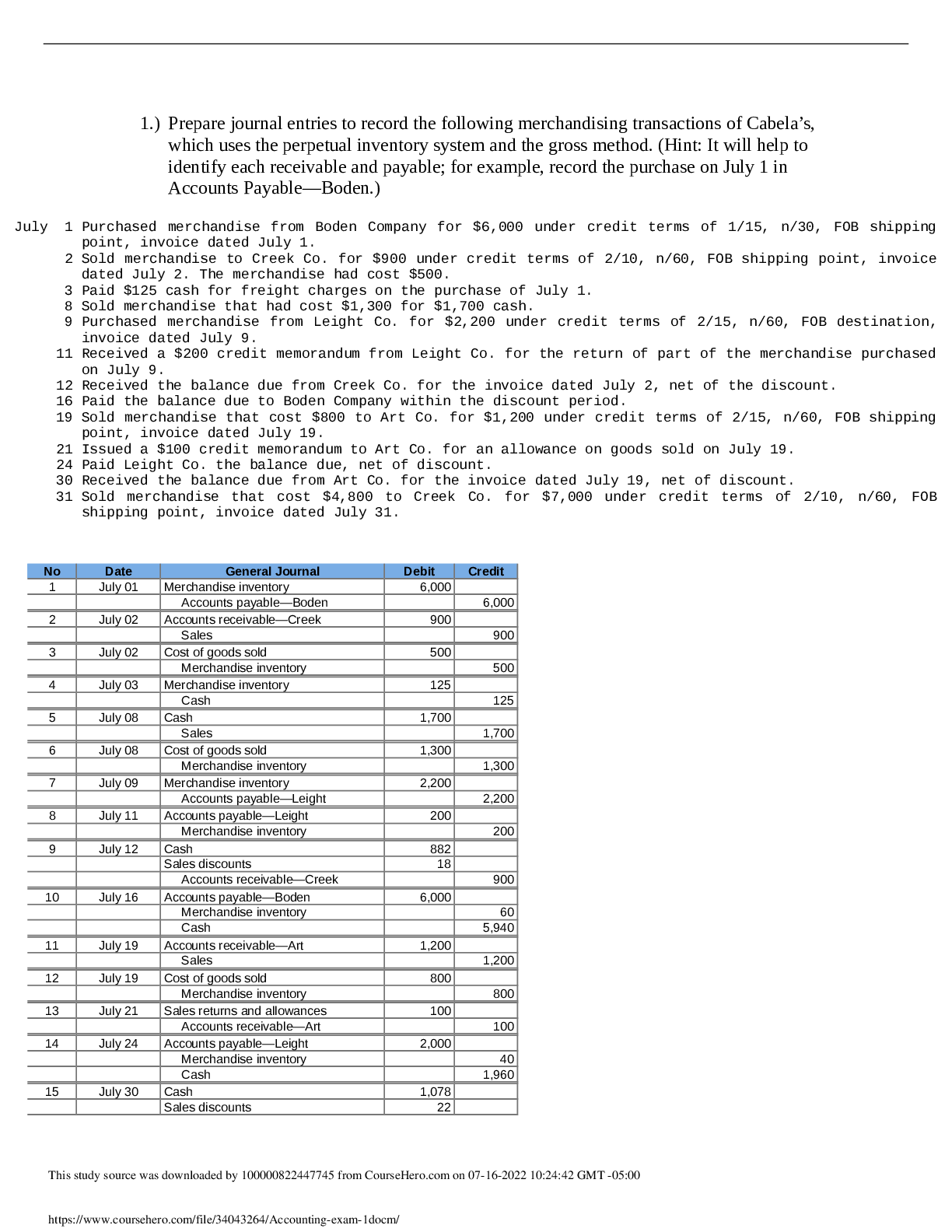
.png)
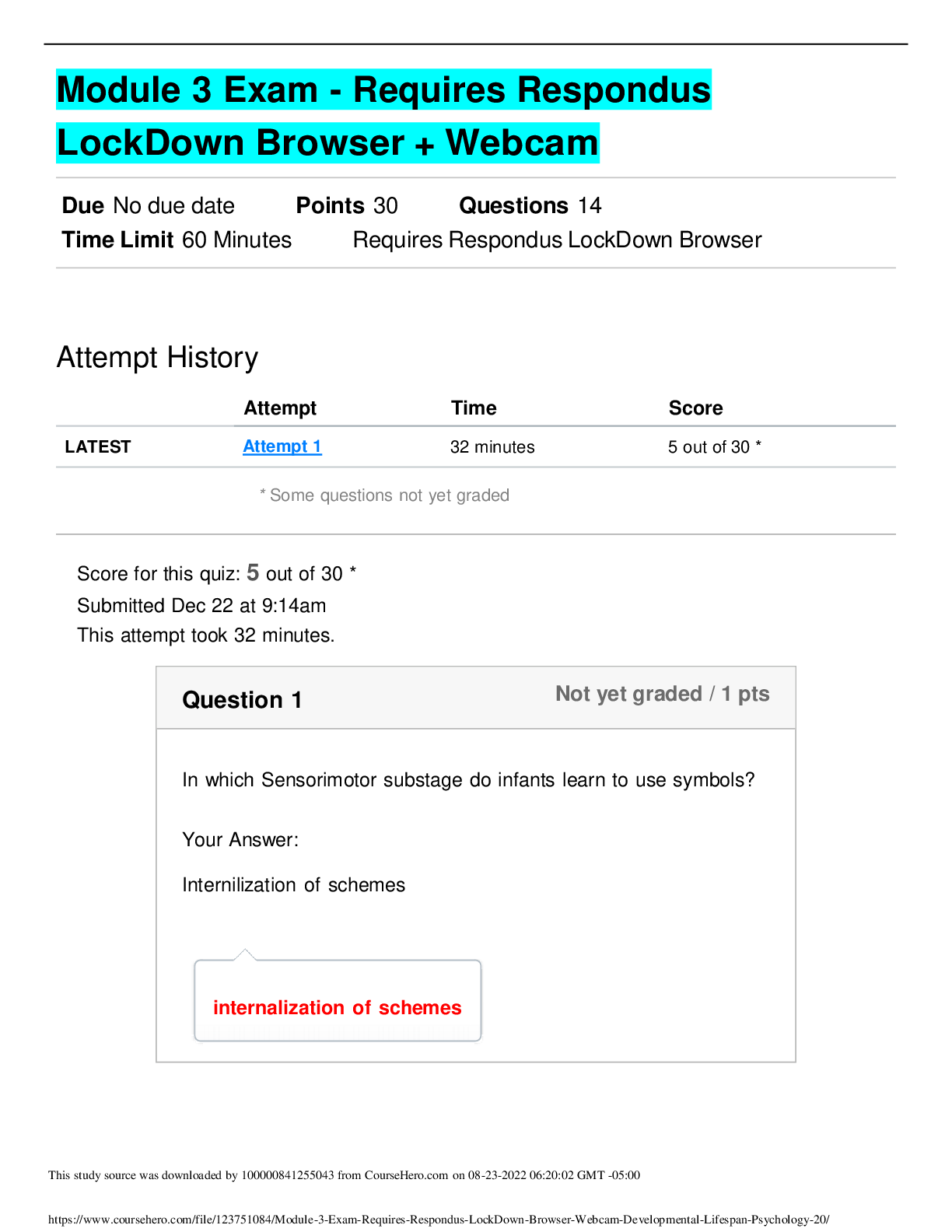


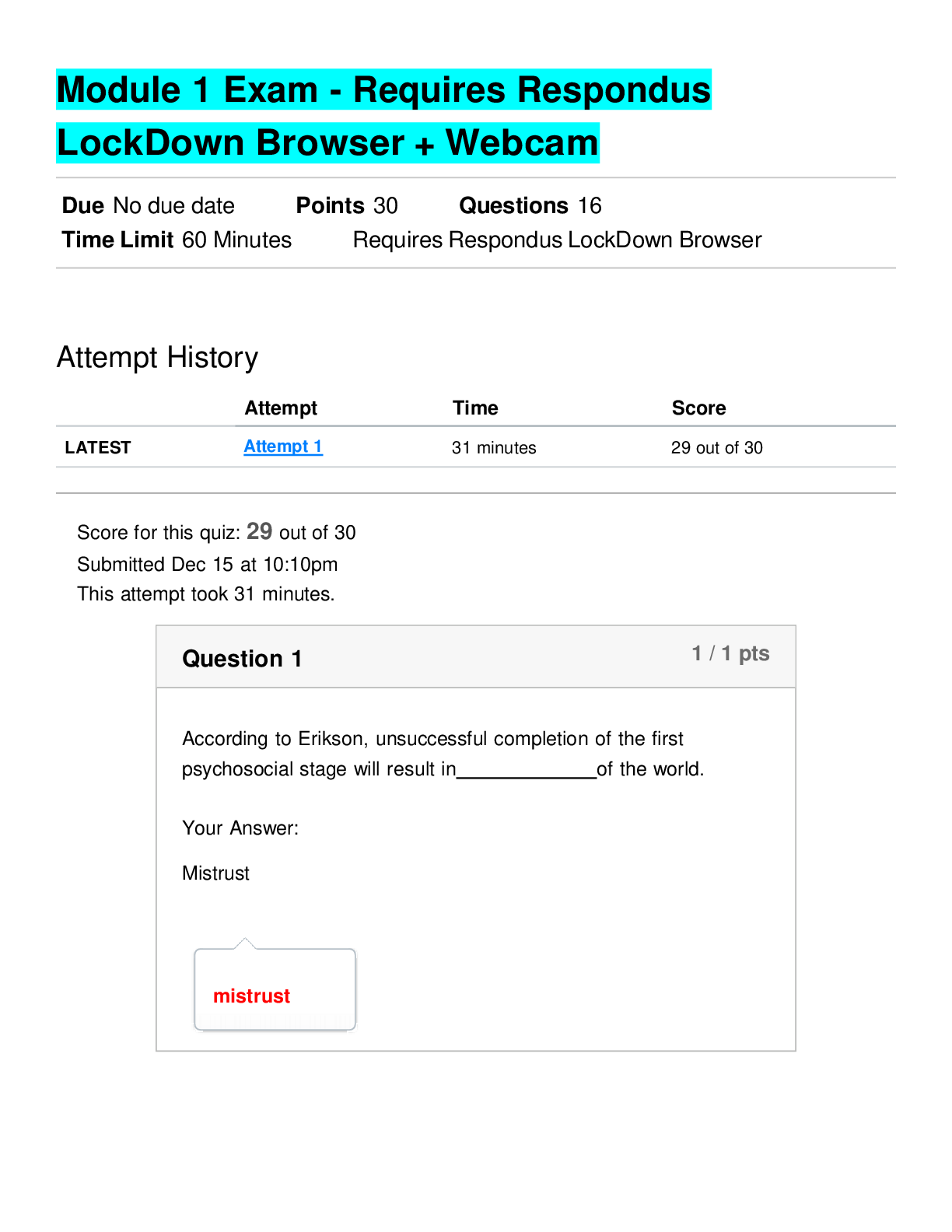

.png)
